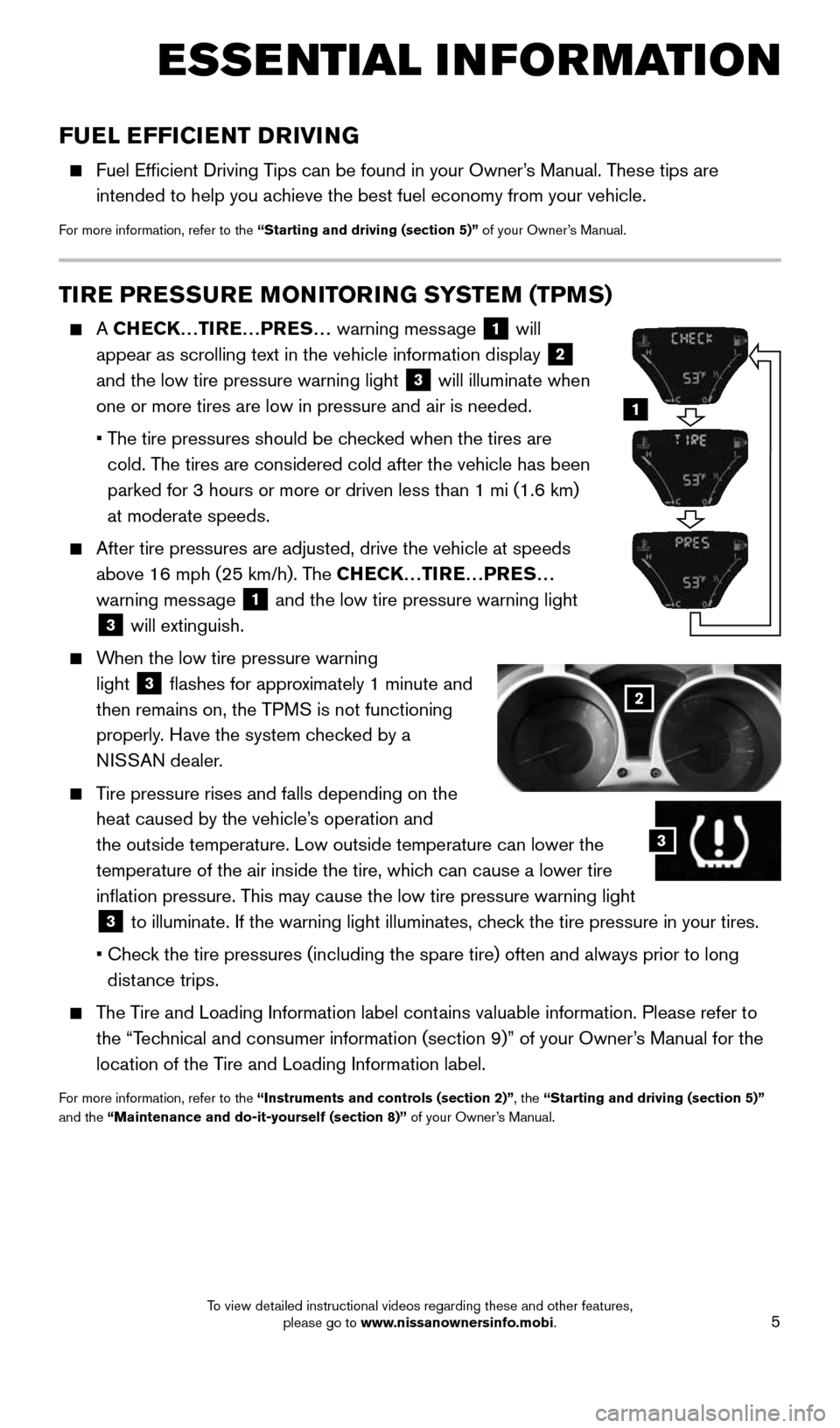Page 2 of 28
2
3
14
5
9
16
13
1718
19
20
21
14
15
12
11
7
6
8
*See your Owner’s Manual for information.1 Vehicle Information Display*2 Headlight and Turn Signal Switch3 Low Tire Pressure Warning Light4 Instrument Brightness
Control Switch*5 Twin Trip Odometer Reset Switch* /
Trip Computer Mode Switch
Wiper and Washer Switch7 Steering Wheel Switches for
Audio* / Bluetooth
® / Siri
® Eyes Free
8 Cruise Control9 Outside Mirror Control Switch10 Paddle Shifters*11 Tilt Steering Adjustment*
12 Vehicle Dynamic Control (VDC)
OFF Switch*13 All-Wheel Drive (AWD) Switch*14 Fuel-filler Door Release15 Hood Release*16 Hazard Warning Flasher Switch*
17 Audio and Navigation System18 Integrated Control System19 Auxiliary Jack*20 USB Connection Port21 Power Outlet*
610
1905578_16a_Juke_US_pQRG_081915.indd 48/19/15 11:07 AM
Page 7 of 28

5
ESSE NTIAL I N FOR MATION
FUEL EFFICIENT DRIVING
Fuel Efficient Driving Tips can be found in your Owner’s Manual. These tips are
intended to help you achieve the best fuel economy from your vehicle.
For more information, refer to the “Starting and driving (section 5)” of your Owner’s Manual.
TIRE PRESSURE MONITORING SYSTEM (TPMS)
A CHECK…TIRE…PRES… warning message 1 will
appear as scrolling text in the vehicle information display
2
and the low tire pressure warning light
3 will illuminate when
one or more tires are low in pressure and air is needed.
• The tire pressures should be checked when the tires are
cold. The tires are considered cold after the vehicle has been
parked for 3 hours or more or driven less than 1 mi (1.6 km)
at moderate speeds.
After tire pressures are adjusted, drive the vehicle at speeds
above 16 mph (25 km/h). The CHECK…TIRE…PRES…
warning message
1 and the low tire pressure warning light
3 will extinguish.
When the low tire pressure warning
light
3 flashes for approximately 1 minute and
then remains on, the TPMS is not functioning
properly. Have the system checked by a
NISSAN dealer.
Tire pressure rises and falls depending on the
heat caused by the vehicle’s operation and
the outside temperature. Low outside temperature can lower the
temperature of the air inside the tire, which can cause a lower tire
inflation pressure. This may cause the low tire pressure warning light
3 to illuminate. If the warning light illuminates, check the tire pressure in your tires.
• Check the tire pressures (including the spare tire) often and always prior\
to long
distance trips.
The Tire and Loading Information label contains valuable information. Please refer to
the “Technical and consumer information (section 9)” of your Owner’s Manual for the
location of the Tire and Loading Information label.
For more information, refer to the “Instruments and controls (section 2)”, the “Starting and driving (section 5)”
and the “Maintenance and do-it-yourself (section 8)” of your Owner’s Manual.
2
3
1
1905578_16a_Juke_US_pQRG_081915.indd 58/19/15 11:07 AM
To view detailed instructional videos regarding these and other features, please go to www.nissanownersinfo.mobi.
Page 8 of 28

6
ESSE NTIAL I N FOR MATION
TOWING YOUR VEHICLE
ALL-WHEEL DRIVE (AWD) VEHICLE
An all-wheel drive vehicle must be towed with all wheels off the ground \
even if the
vehicle is in the 2WD mode.
For proper towing and to avoid accidental damage to your vehicle, NISSAN recommends
that a service operator tow your vehicle after carefully reading the Own\
er’s
Manual precautions.
For more information, refer to the “In case of emergency (section 6)” of your Owner’s Manual.
LOOSE FUEL CAP
A LOOSE FUEL CAP warning message will
appear in the vehicle information display
1
when the fuel-filler cap is not tightened correctly.
To tighten, turn the cap clockwise until a single
click is heard.
The indicator will extinguish when the vehicle detects the fuel-filler \
cap is properly
tightened and the reset button
2 is pressed for more than 1 second.
If the cap is not properly tightened, the Malfunction Indicator Light
may illuminate.
For more information, refer to the “Instruments and controls (section 2)” and the “Pre-driving checks and
adjustments (section 3)” of your Owner’s Manual.
1
2
FUEL-FILLER DOOR
To open the fuel-filler door, pull the release 1
located on the lower instrument panel to the left
of the steering wheel.
The fuel-filler door is located on the passenger’s
side of the vehicle.
For more information, refer to the “Pre-driving checks and
adjustments (section 3)” of your Owner’s Manual.
1
1905578_16a_Juke_US_pQRG_081915.indd 68/19/15 11:07 AM
To view detailed instructional videos regarding these and other features, please go to www.nissanownersinfo.mobi.